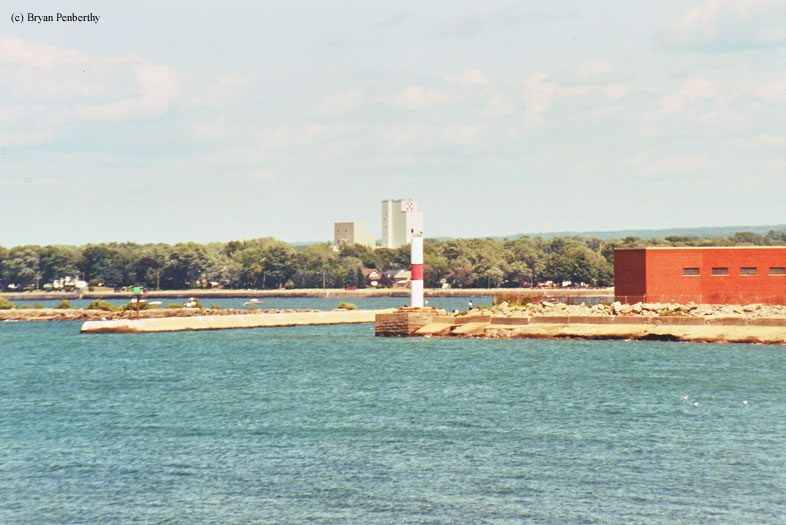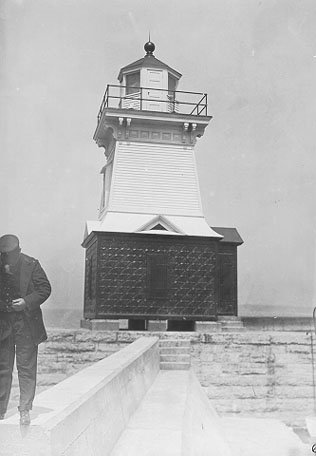Dunkirk Pierhead Lighthouse
Dunkirk, New York - 1992 (1828**)

History of the Dunkirk Pierhead Lighthouse
Posted/Updated by Bryan Penberthy on 2015-02-07.
After the Dunkirk Lighthouse was established at Point Gratiot in 1827, the United States government continued making improvements to the harbor. Nearly ten years later, the Dunkirk Pierhead Lighthouse was erected to mark the entrance.
To improve the harbor at Dunkirk, Congress appropriated $3,000 on March 2, 1827 for construction of a pier. Between 1828 and 1834, Congress appropriated an additional $26,600 for harbor improvements.
On March 3, 1837, Congress appropriated $2,700 for a pierhead beacon at Dunkirk. Constructed was an octagonal tapering brick tower, which led to a flared brick cornice supporting an octagonal gallery. The lantern was polygonal surrounded by an iron pipe railing.
When completed, the beacon light on the pier and the Dunkirk Lighthouse on the bluff formed a range guiding vessels through the most difficult part of the channel. The keeper of the Dunkirk Lighthouse was responsible for both lighthouses.
When the pierhead lighthouse was established in 1837, Congress felt the 1827 Dunkirk Lighthouse atop the bluff was unnecessary and ordered it to be discontinued.
By 1838, many of the nation's lighthouses were being inspected and reported on by various members of the U.S. Navy. In the tenth lighthouse district, which spanned from the St. Lawrence River down into Ohio, Lieutenant Charles T. Platt handled the reviews.
In his report, he stated that the harbor, partially formed by artificial means, was spacious and well protected. He went on to report that the lighthouse was discontinued by the authority of congress and had this to say about it:
The light-house at this point has, by the authority of Congress, been discontinued, at your discretion. This step has been taken, in my opinion, unadvisedly; or, rather, the evidence before Congress, upon which decision is predicated, was premature. It is a matter of surprise to me that it should have been recommended. Surely the recommendation could not have emanated from the ship-masters navigating the lake; for there is not a light-house on the south shore of Lake Erie that is more conspicuous, or can be seen to a greater distance.
He continued:
It might have been presumed that the beacon would supersede the necessity of the light-house. This, however, is not the fact; for a single light upon the piers would require an elevation of one hundred and twenty-five feet to overtop the bluff point on the northwest, and even in that case not afford the proper facilities for navigation.
He concluded his report stating that the lighthouse, the dwelling, and the beacon were all in excellent order, with no deficiencies. Shortly after the filing of his report, the Dunkirk Lighthouse was reinstated.
With the establishment of the United States Lighthouse Board in 1852, the system of lighthouses, fog bells, and buoys were removed from oversight by the U.S. Treasury department and put under the auspices of a group, which consisted of distinguished military officers, and civilian scientists who understood the business.
In 1854, the Dunkirk beacon light was listed as being served by a "large lens lantern for 225°." A few years later, it was listed as having three lamps to provide the light.
By 1869, the beacon light had required considerable maintenance. The Annual Report of the Secretary of the Treasury on the State of the Finances had listed the following as being done:
The exterior of the beacon has been resheathed, painted, and sanded; its foundation strengthened, new stairs and ceiling supplied, decking and glass frames repaired, and lantern door refitted.
Several years later, in 1873, an elevated walkway was extended 900 feet to the beacon to provide the keeper safe passage during inclement weather. The report for that year described the beacon as "old and needs renewing," and requested an appropriation of $5,000.
Over the years, it appeared that nothing was done as the Annual Report of the Lighthouse Board for 1875 described the beacon as "old and the wood-work much decayed." In the report, the Lighthouse Board again asked for $5,000 to replace it.
The same verbiage was entered into the 1876 report as well. Still, it appeared that nothing was done as the Annual Report of the Lighthouse Board for 1878 had the following entry:
540. Dunkirk Beacon, Lake Erie, New York - Its condition is such that it is no longer safe. The outside planking is very rotten, and the lantern floor, which is of flag-stone, is steadily settling. The tower was built in 1837, and is a rough structure. The lantern is of an old pattern, 15 small panes in a side, with broad astragals, and high balustrade stanchions outside. A new tower should be built without delay. Unless this is done, considerable repairs will be unavoidable to insure safety during the winter gales, and the structure is not worth it.
No entry appeared for the Dunkirk Beacon in 1879, however, in 1880, the entry stated that the elevated walk was repaired, and a new tower was under construction.
By 1881, a new beacon was erected. The Annual Report of the Lighthouse Board for that year had the following entry:
584. Dunkirk Beacon, southwest side of entrance to Dunkirk Harbor, Lake Erie, New York - The stone foundation for the new iron beacon was built, the beacon was set up, lined with wood, and painted; the tower windows and the ventilators of the lantern and cowl were supplied with wire screens. The outside steps of the beacon were lengthened, stanchions were put up, and guard-chains were stretched from the end of the elevated walk to the beacon, a locker and bunk built in the beacon, a lightning-rod was put up, and the station in general was put in excellent order.
 1899 Dunkirk Pierhead Lighthouse (CG)
1899 Dunkirk Pierhead Lighthouse (CG)
The following year, 880 feet of the elevated walk were rebuilt, the roof of the assistant keeper's dwelling was reshingled, and a porch was built at the west entrance of the dwelling.
In the fall of 1886, some 210 feet of the elevated walk were repaired. An additional 300 feet was going to be replaced in 1887, however, due to several gales, both the substructure and the superstructure needed repairs. As only funds to fix the substructure were available, the rebuilding of the elevated walk was put off.
By 1889, the superstructure of the pier was still not repaired. This once again delayed the repair of the elevated walkway. Gales later that winter destroyed the substructure of the pier that supported the block-stone foundation of the tower.
On August 15, 1895, the color of the light was changed from white to red. The light would only be in service for another six months before being washed away during a gale on December 12, 1895. A temporary wooden beacon was erected near the end of the pier and was exhibited for the first time at the opening of navigation on April 17, 1896.
That year, designs for a new stone and concrete pier were drawn up. The lens lantern in use on the temporary light was replaced on July 25, 1896 with a tubular lantern, which increased its intensity.
The assistant keeper, who was responsible for the pierhead light, had his dwelling rebuilt in March of 1897. By the following year, a new foundation and crib work for the pier was in progress and was completed in 1899.
The new Dunkirk Pierhead Lighthouse was completed by August 31, 1899. It was a wooden, square, pyramidal tower with clapboard siding, square gallery, and a polygonal lantern. The light was exhibited from the new tower on September 15 of that year.
As it was no longer needed, the temporary wooden tower that served Dunkirk Harbor from 1895 to 1899 was transferred to the north pier in Erie Harbor, Pennsylvania to be used as a fog bell tower.
When a pier is extended several hundred feet into the Great Lakes, you leave it at the mercy of the lake. As happened all around the Great Lakes, including the pier belonging to the Rochester Harbor beacon and the pier on which the Oak Orchard Lighthouse sat on, the pier at Dunkirk was under constant assault from the force of Lake Erie.
During the fiscal year 1900 / 1901, the Dunkirk Pierhead beacon required repair twice due to storms. As sections of the pier were washed away, temporary planking was put down to allow the keeper to reach the lighthouse.
The 1899 lighthouse served the harbor until its replacement in 1939 by a steel skeletal tower. The skeletal tower was in use until 1992, when it was replaced with a modern light, which continues to serve today.
Today, the 1939 steel skeletal tower sits on the grounds of the Dunkirk Lighthouse and Veterans Museum nearby on Point Gratiot.
Reference:
- Great Lakes Lighthouses Encyclopedia, Larry & Patricia Wright, 2011.
- Annual Report of the Light House Board, U.S. Lighthouse Service, Various years.
- Various Government Documents, Federal & State Governments, Various dates.
Directions: The lighthouse is visible from the grounds of the Dunkirk Lighthouse. From I-90, get off at exit 59 (Dunkirk) and take Route 60 north towards the lake. At Route 60 and Route 5 intersection, make a left onto Route 5. Follow Route 5 for a little more than one mile west. You will now see signs leading you to the lighthouse. You will make a right onto Point Drive North, and follow that into Point Gratiot Park.
For more information, please visit the official website: http://www.dunkirklighthouse.com.
Accesss: The current modern tower is owned by the United States Coast Guard. The pier on which it sits looks like it is open for walking. The 1939 skeletal tower is owned by the Dunkirk Lighthouse and Veterans Museum. The grounds of the museum are open in season.
View more Dunkirk Pierhead Lighthouse picturesTower Height: Unknown
Focal Plane: 36'
Active Aid to Navigation: Yes
*Latitude: 42.49300 N
*Longitude: -79.34500 W
See this lighthouse on Google Maps.
